Irish Grid Monthly Recap, September 2024
Welcome! You are reading the first edition of Currents, a newsletter by Green Collective. On the first day of each month, we send out a recap of what's been happening recently on the Irish grid along with some suggested further reading. For this inaugural issue, we've also included, at the end, a little background on how we evolved from Irish Energy Bot on Twitter/X to the Green Collective of today. If you enjoy this recap, please forward it to someone else you think might be interested!
Irish Grid Monthly Recap
Summary
Generation from renewable sources during September 2024 was equivalent to 31.6% of all-island electricity demand:
- 28.3% wind
- 0.7% hydro
- 0.3% biomass
- at least 2.3% solar
1014.8GWh was the second-highest amount of renewable generation yet seen during a September month, beaten only by 2023's 1110GWh. This is the third time that September renewable generation has exceeded 1TWh; the first occurrence was in September 2019.
Peak renewable output of 4302MW at lunchtime on Sunday 29th set a new September record, beating 2023's 4077MW by some distance. This was a stormy day and renewable generation at the time was comprised almost entirely of wind; more on this new record below.
Fossil fuel generation was equivalent to 53% of demand. This was the second-lowest share for fossil fuels in a September month, just a fraction higher than September 2023's 52.1%. This continues a welcome sharp decline in fossil fuels' share of September electricity supply which exceeded 70% in 2021 and 2022. We can attribute this sharp decline chiefly to an increased reliance on imports.
So far during 2024, renewable generation has equalled 37.1% of electricity demand and fossil fuels 49.6%.
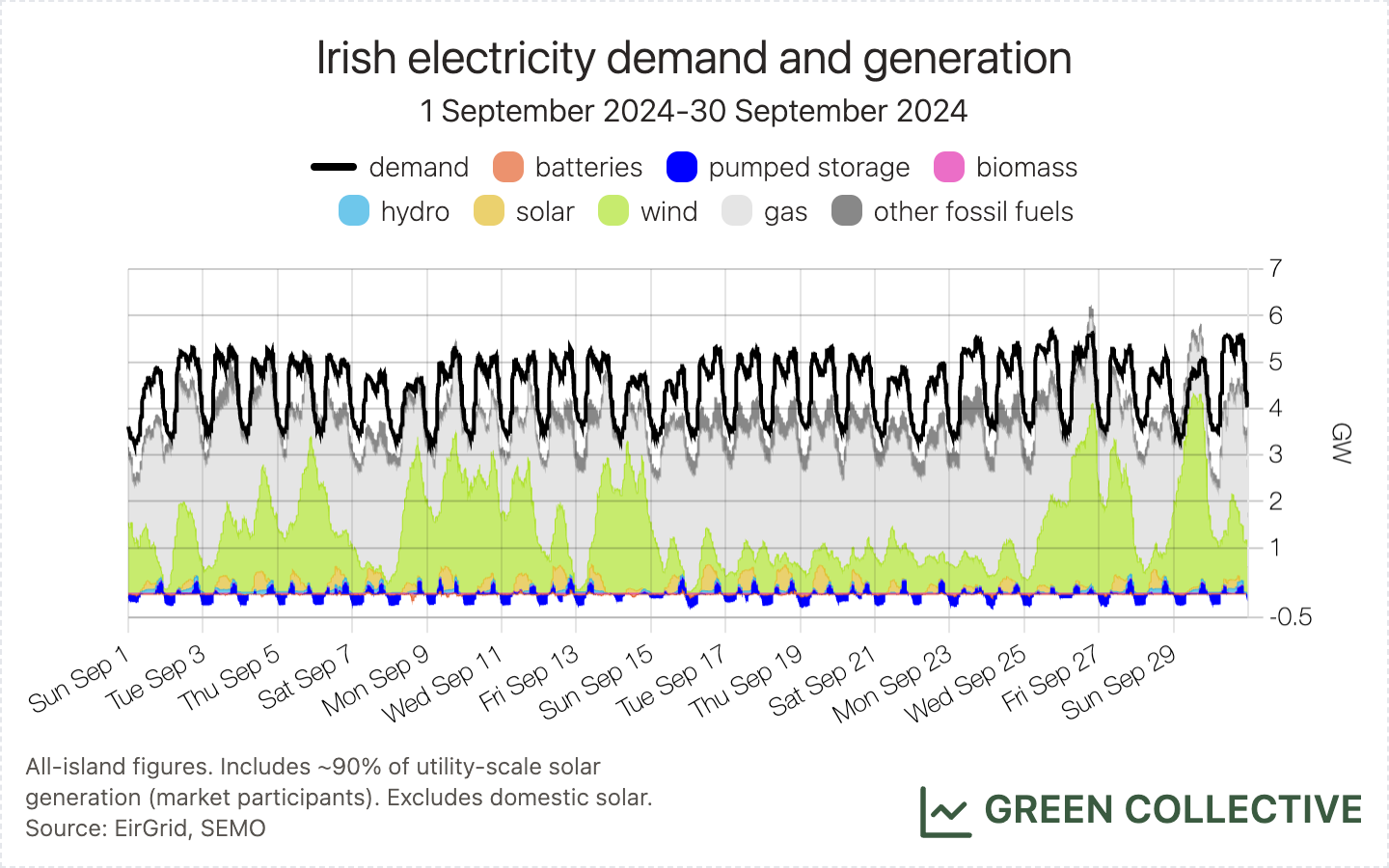
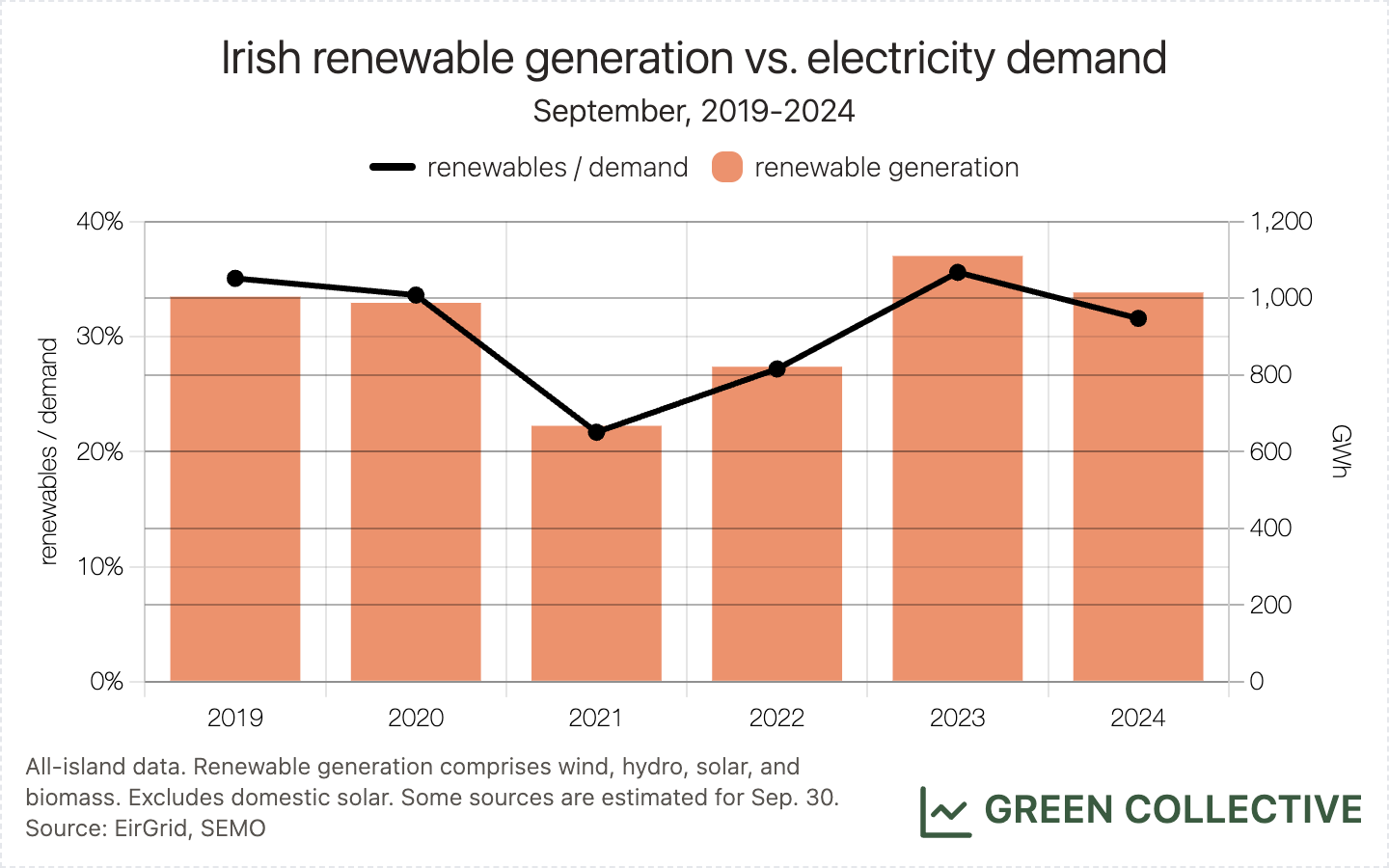
Top Counties for Wind and Solar
Top counties for wind:
- Kerry
- Cork
- Tipperary
Top counties for solar:
- Meath
- Wexford
- Cork
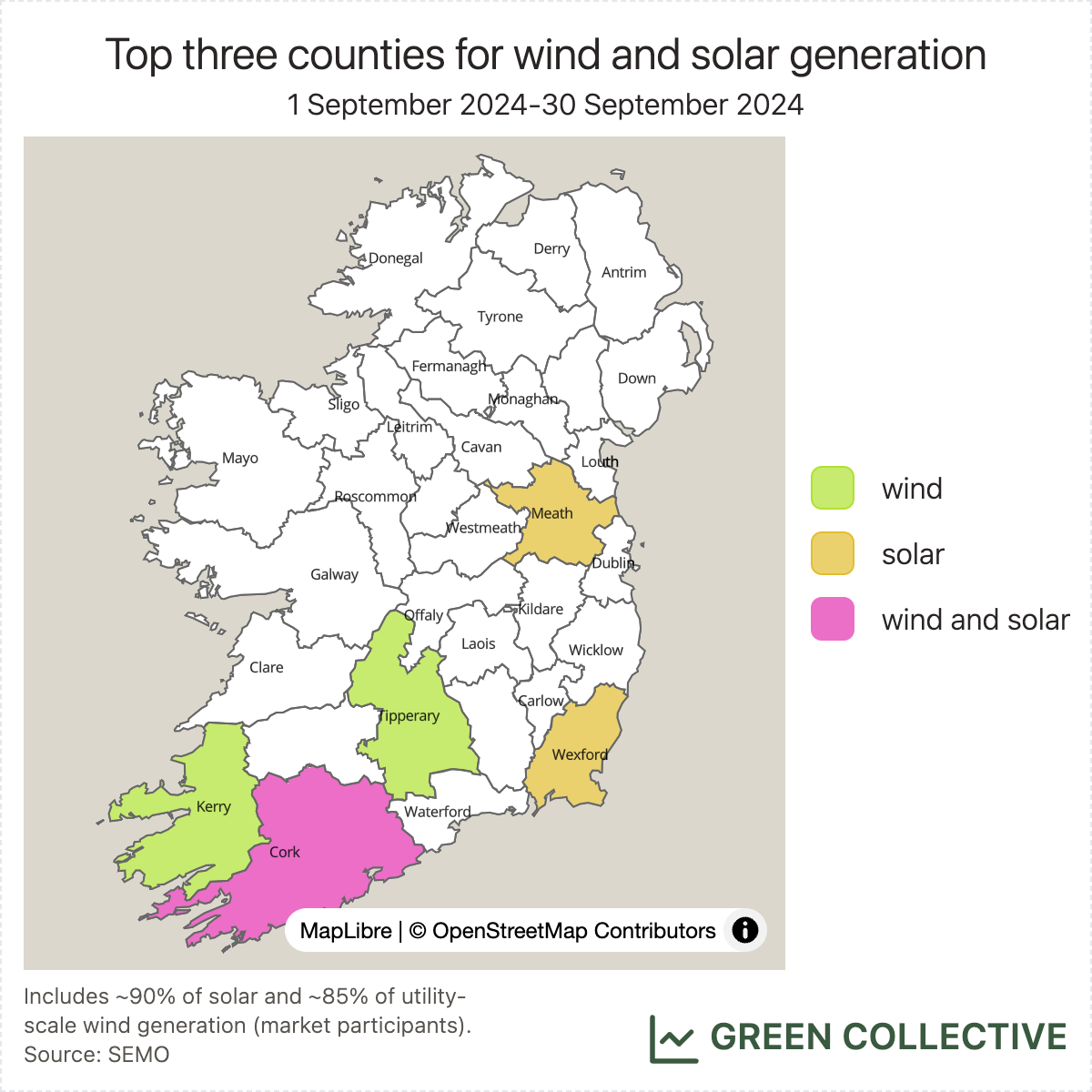
Wind
908.9GWh from wind power was typical for September but significantly less than 2023's 995.9GWh. However, we did observe a new wind output record for a September month: 4158MW on Sunday 29th. This was equal to 89.8% of demand at the time. As with other monthly wind output records set this year, we can attribute this chiefly to the handful of new wind farms that have come online in the past couple of years.
Counties Cork and Kerry both produced over 100GWh from wind power, Kerry just pipping Cork for top position. Between them, the two southern counties accounted for approximately 24% of the month's wind generation. At their peak around lunchtime on the stormy Sunday September 29, Cork and Kerry wind farms were supplying approximately 27% of all-island demand.
Solar
Irish solar ends its record-breaking run: this is the first month since March that we cannot report a significant new record.
However, solar continues to perform strongly as we approach winter: peak monthly solar output this month was 603MW on September 19 which we will likely be able to revise to ~660MW once Eirgrid releases utility-scale data. This isn't so far from the current all-time high of 719MW, itself set in late August. Though the days will of course continue to grow shorter, this and the continued addition of new solar farms may yet help us see solar output records broken again before the end of the year. More on one such recent addition, Timahoe North in Kildare, below.
As in recent months, County Meath was home to approximately 50% of the month's solar generation with the next largest producer, County Wexford, well behind on approximately 22%.
Carbon Emissions
We estimate that for each kWh of electricity generated in September the Irish grid emitted between between 110g and 467g of CO2, for an average of 286gCO2/kWh.
As has been the case each month so far this year except for July, this was the lowest grid carbon intensity yet seen for a September month, just below September 2023's 293g.
So far in 2024, the average carbon intensity of the Irish grid has been 258gCO2/kWh.
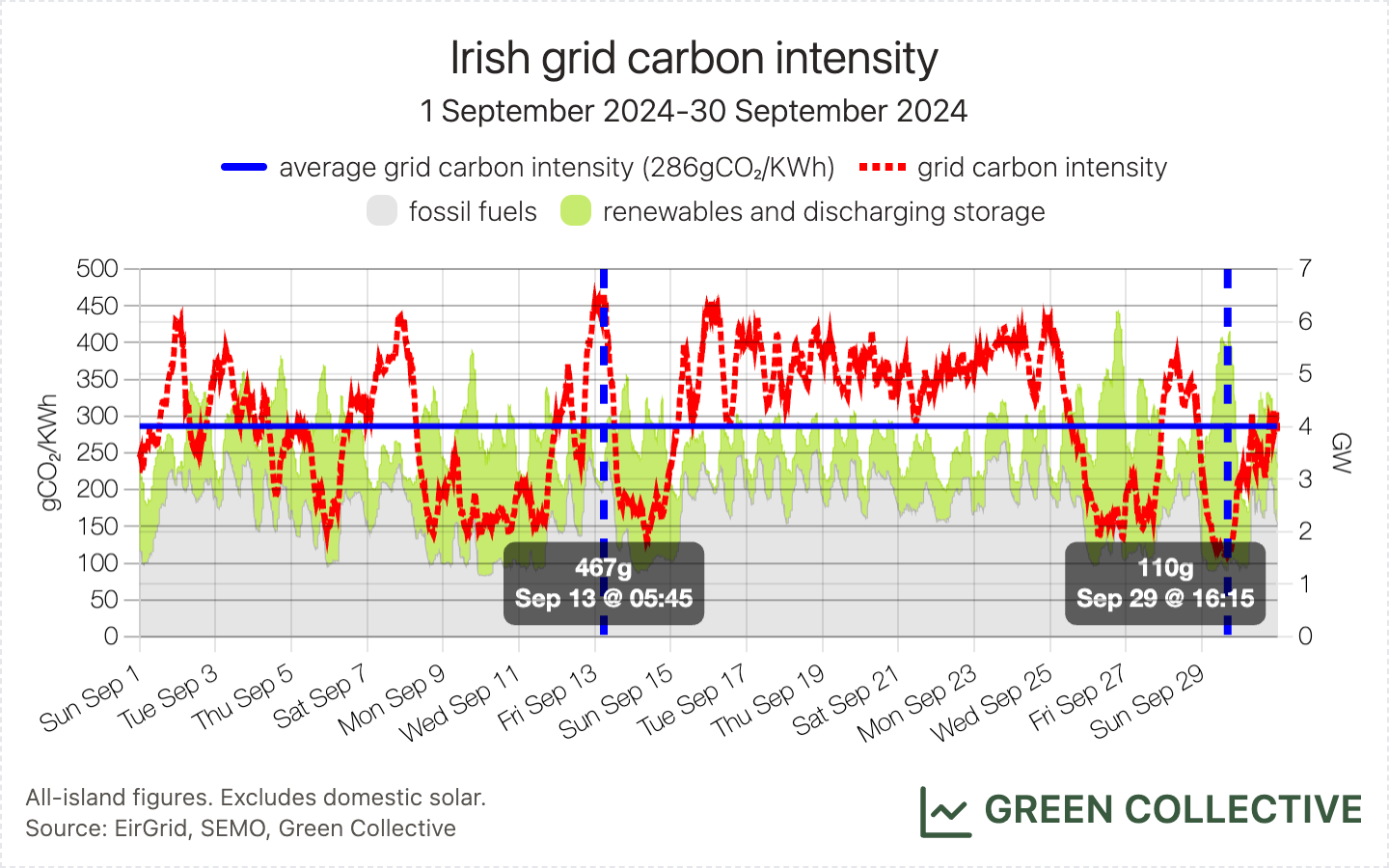
Disclaimer and Updates
Additional data for this month, e.g. utility-scale solar generation not registered with the market operator, will become available over the next few weeks and may change some of the numbers above slightly. We will update when necessary and you can always find the most up-to-date monthly recaps on our website.
Hatches and Dispatches
We track the publications of multiple network operators to find newly connected and retired generating capacity. Delays are common in these documents but we've picked out some highlights to give you a sense of what's coming and going on the grid:
- Cloncreen BESS (battery energy storage system) in Offaly was energised in August. This is the second clean energy facility Bord na Móna has built on the Cloncreen bog, in addition to a wind farm online since 2022. Cloncreen BESS has a capacity of 25MW/75MWh, currently the longest duration battery on the island of Ireland.
- Timahoe North solar farm in Kildare, co-developed by Bord na Móna and ESB, started generating electricity in September. Similarly to Cloncreen wind and batteries, Timahoe North is also located on bogland. With an eventual capacity of 108MW, this utility-scale solar farm is set to make Kildare a top county for solar generation.
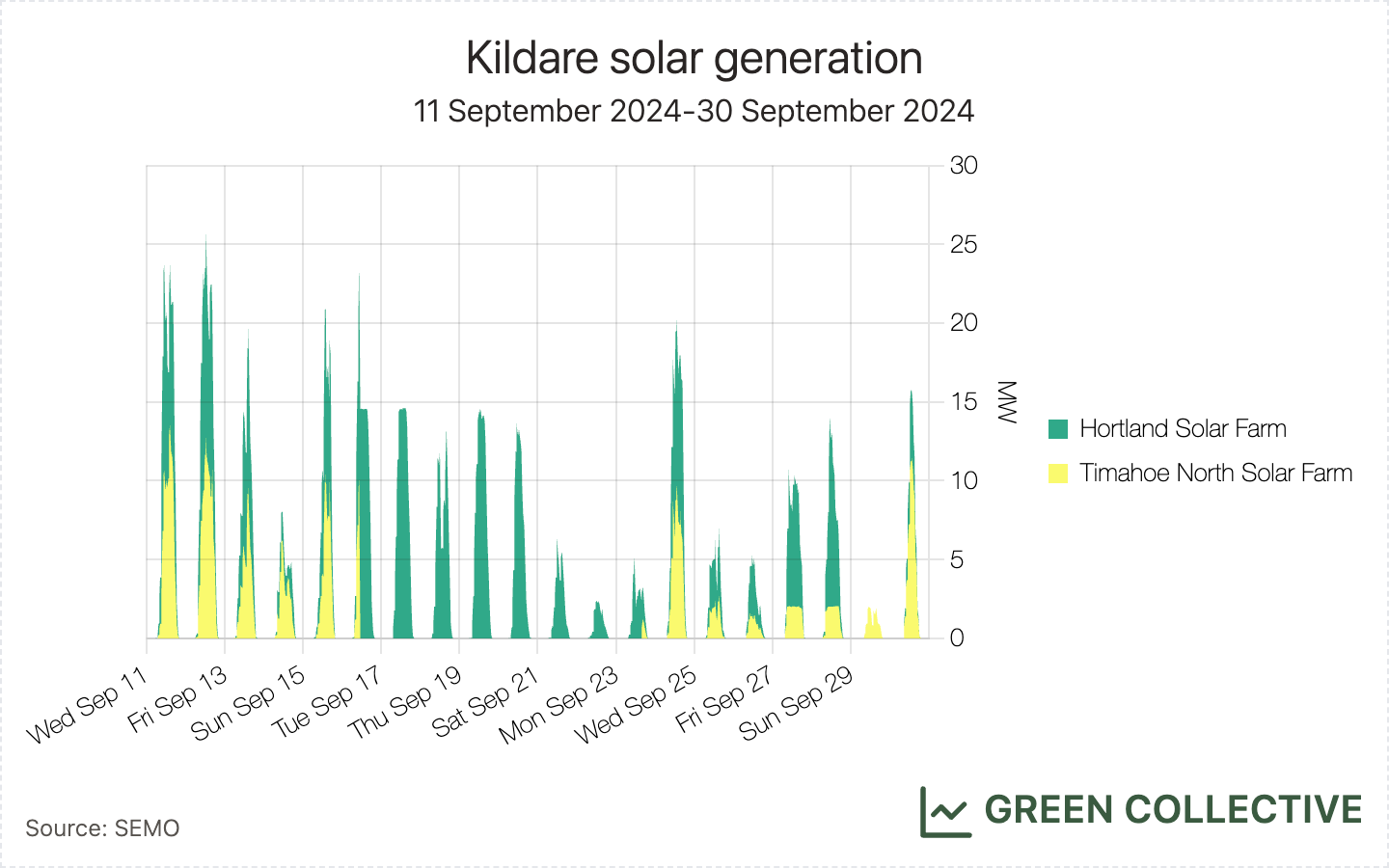
- The Greenlink Interconnector has been registered with the single electricity market operator (SEMO) since late July, indicating the project has completed its construction phase. This project of 500MW provides additional interconnection between Ireland and Wales and is expected to be operational by the end of 2024.
Further Reading
- We talked to Sam Tranum at the Dublin Inquirer about long-duration energy storage in Ireland. It's fantastic to see local journalism tackle complicated topics such as the prospects of iron-air batteries with in-depth and fair coverage.
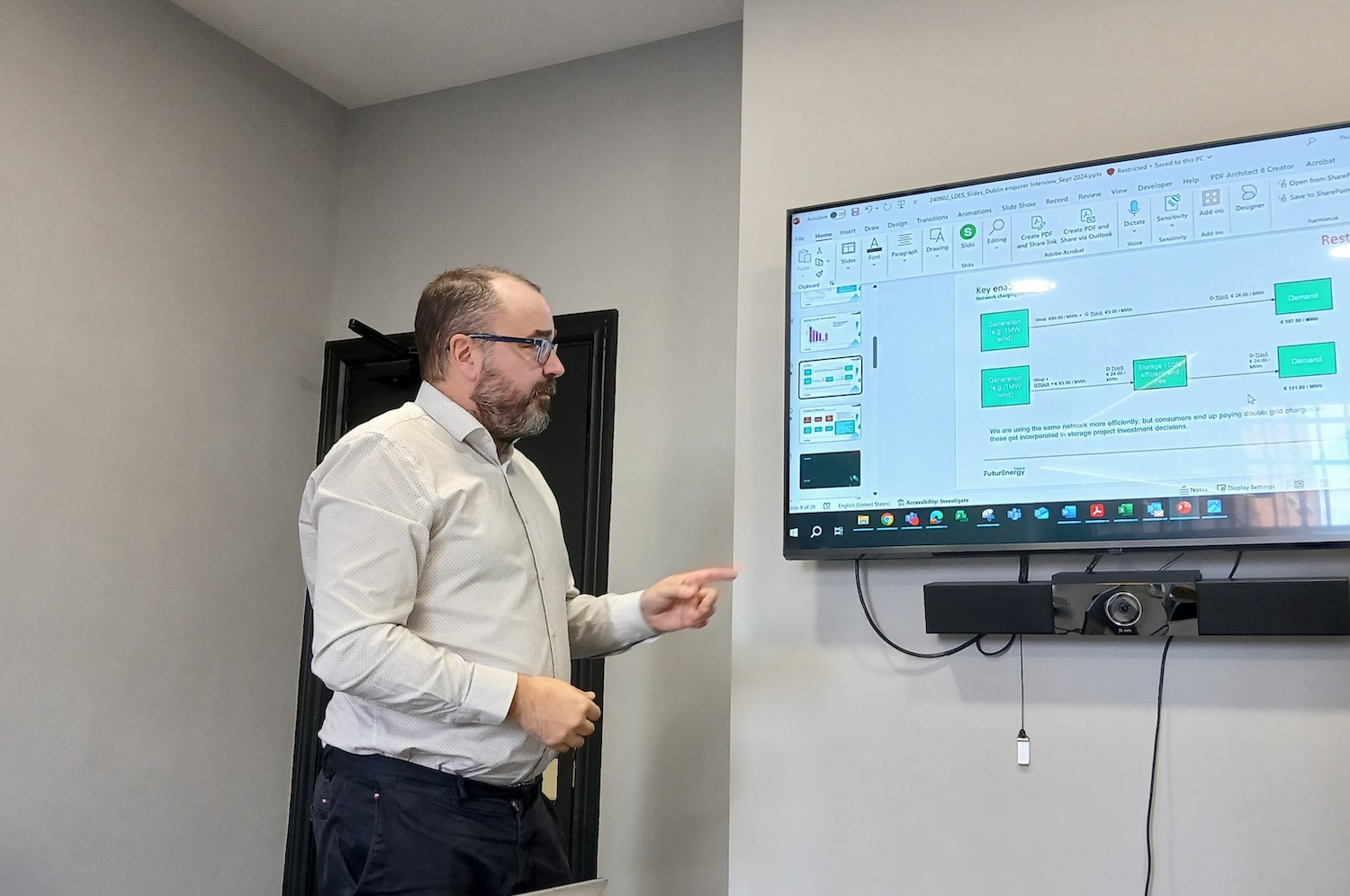
- Ember, the energy think tank with extensive data on the power sector, published a report last week analysing hourly generation in EU-27 countries. The report illustrates solar is possible anywhere: if the Netherlands (famously grey, no offense) can witness solar generation outstripping demand during certain hours, there are few excuses for anyone else. Clean flexibility like batteries and interconnectors are complementary and necessary to increasing wind and solar generation. We're proud to have contributed Irish hourly data to this report: EU battery storage is ready for its moment in the sun.
An Inaugural Special
For the curious, a quick recap of our story so far...
Firstly, allow us to (re-)introduce ourselves. We're Trevor Johnston and Fei Wang, a couple that started the Irish Energy Bot as a pandemic project when we were trying to cope with life in a small apartment in New York City. Trevor is a software engineer who spent more than a decade at Google and Fei is an energy analyst who has worked on projects throughout the electricity system value chain. Trevor is Irish and we knew that Ireland had lots of wind power but few people were aware of this. So, we decided to combine our strengths in software engineering and power sector knowledge to create Irish Energy Bot, a Twitter account providing a daily snapshot of wind energy on the Irish grid, in August 2020.
The underlying data supporting the charts and graphs shared through the Irish Energy Bot is all publicly available but that doesn’t mean it’s easy to gather and analyse. For the past four years, we have collected publicly available grid data for the island of Ireland. It started with wind and demand, then expanded into mapping locations of generators across the island. Since last year, we also added operational data such as granular plant-level metered generation to our database.
A main goal of the Irish Energy Bot is to make publicly available data more accessible. Four years into the exercise, we've amassed an extensive dataset and have started producing more in-depth analysis. As Twitter/X took a turn for the worse, we knew our data and insights would eventually need a different home. We registered our partnership/company Green Collective in 2023 and have hosted our dashboard and insights on our website since then.
We have some exciting efforts in the works, such as publishing our own dataset covering historical Irish generation at a fine-grained level as open data. With this newsletter we hope to reach people who are interested in the electric grid, renewable energy, climate change, data visualisation and more. If you know someone else who’d be interested in reading this, we’d greatly appreciate it if you forward them this issue!
You can also follow us on Bluesky and LinkedIn or send us feedback at hello@greencollective.io.
